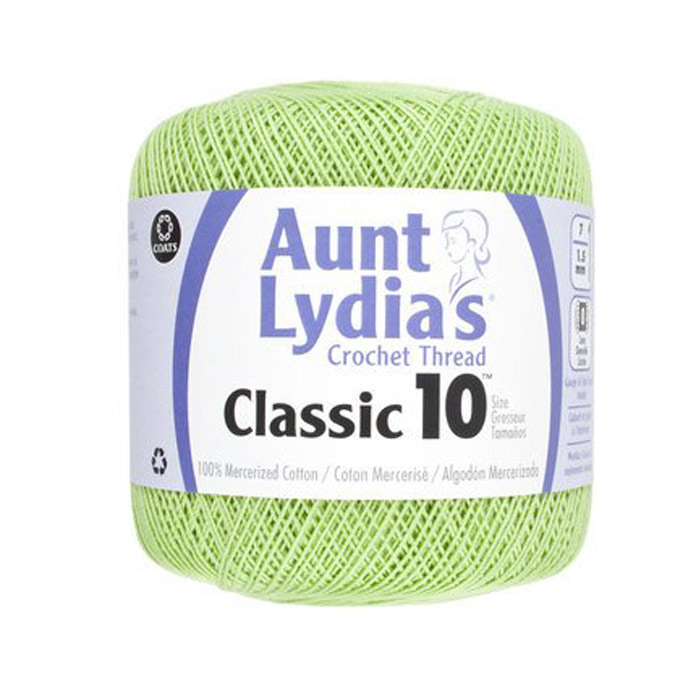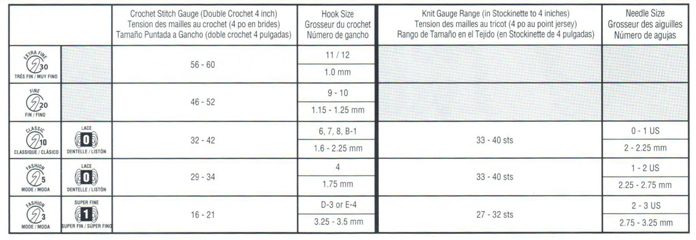Aunt Lydia’s been around for donkey’s years, as my beloved, late mother-in-law would say. She’s visited many houses over a span of more than 100 years! So, who is this socialite auntie?
Aunt Lydia‘s is a crochet thread! I grew up with her little sister, who doesn’t have a name but goes simply by South Maid. I still have some balls of South Maid that came from my grandmother’s stash. Both threads are produced by Red Heart and still bear the Coats & Clark label on the ball band.

Aunt Lydia’s Classic 10 comes in 55 vibrant colors, including Victory Red. Each unit comes with a protective plastic coating.
There are several weights of Aunt Lydia’s thread, size 3, 10, 20 and 30. This week, I’m working with Classic 10, but before I get to work, I want to explain the sizing.
There are many technical ways of measuring the thickness of threads and yarns. There’s one for wool, one for nylon, and one for cotton, among others. The cotton system is very consistent, in part because cotton fibers themselves are fairly consistent from one type of cotton plant to another. The measurement system is called the British Cotton Count (NeC), and it makes it possible for crocheters and knitters to know with absolute certainty how thick their yarn will be.
If I made a project with size 20 cotton in 1983, I can go out today, purchase a new ball of size 20 cotton, and be certain I’ll get the same result using the same pattern and needles as I did 36 years ago. That’s not always possible with a woolen or acrylic double knitting yarn.
With the cotton count system, the lower the number, the thicker the yarn. A size 3 or size 5 cotton will make great garments. A size 3 gives about the same tension as a light fingering yarn – 27 to 32 stitches over 4″ [10cm] when using size 2 or 3 [2.75 or 3.5mm] needles. A size 10 cotton, using size 0 or 1 [2 or 2.25mm] needles, will yield a tension upward of 40 sts to 4″ [10cm] (these numbers are usually based on plain stockinette stitch).
Every ball band of Aunt Lydia’s has this handy tension chart for crochet and knitting on the inside.

The column on the right shows the knitting gauge range for various sizes of needles. Aunt Lydia’s Classic 10 information is just below the grayed-out rows.
There is a definite advantage to knitting with yarns that are this fine: they give great bang for the knitting entertainment buck! 350 yards [320m] of Aunt Lydia’s Classic 10 will make at least half a dozen knitted Christmas tree ornaments, or at least one placemat, for the princely sum of about $3.50 (at time of writing).
If you measure your knitting yarn consumption in dollars per hour of knitting time, knitting with crochet cotton offers knitting amusement literally for pennies per hour! Oh, and cotton threads are durable – durable enough to make hard-wearing items like placemats, dishcloths and curtains.

I made one of these from about 25 yards (23m) of thread leftover from the project later this week. I could likely get a baker’s dozen out of one ball of Aunt Lydia’s Classic 10 crochet thread.
In this post, we’ve learned that cotton threads are consistent, durable, and great value to knit. Join me tomorrow as I examine and talk about several differences between crochet thread and knitting yarns.
This is part 1 of 5 in this series.
Go to part 2: 3 differences between knitting yarn and crochet thread
[shareaholic app=”follow_buttons” id=”23784471″]
